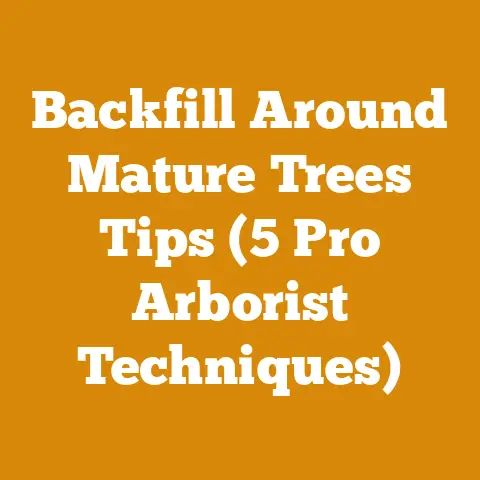Firewood Gloves Guide (5 Kevlar Features You Didn’t Know)
Ever notice how some jobs just feel riskier than others? Handling firewood is one of those. It might not seem like you’re wrestling a grizzly bear, but a stray splinter, a dropped log, or a misjudged swing with a splitting maul can ruin your day faster than you can say “firewood.” That’s where the unsung hero of firewood prep comes in: the humble glove. But not just any glove. I’m talking about firewood gloves with Kevlar. And trust me, there’s more to Kevlar than just bulletproof vests. Let’s dive into 5 Kevlar features you probably didn’t even know existed in firewood gloves and how they can seriously upgrade your wood-splitting game.
The Firewood Gloves Guide: 5 Kevlar Features You Didn’t Know
I’ve been around wood my entire life. My grandfather was a logger, my father continued the tradition, and now I run a small firewood business. I’ve seen it all, from minor cuts and scrapes to more serious injuries, and I can tell you firsthand that a good pair of gloves is the most underrated piece of safety equipment in this business.
In this guide, I’ll break down the often-overlooked world of Kevlar-reinforced firewood gloves, revealing the hidden benefits that can make your wood-splitting experience safer, more comfortable, and more efficient.
Why Kevlar in Firewood Gloves? More Than Just Cut Resistance
When I first heard about Kevlar gloves, I thought, “Okay, cut resistance. Good for avoiding splinters.” But it’s so much more than that. Kevlar offers a unique combination of properties that make it ideal for the demands of firewood preparation.
Here’s a quick rundown of why Kevlar is a game-changer:
- Exceptional Cut Resistance: This is the obvious one. Kevlar fibers are incredibly strong and tightly woven, making them highly resistant to cuts from sharp objects like axes, saws, and even those sneaky little splinters.
- Abrasion Resistance: Firewood work is rough on gloves. Dragging logs, handling rough bark, and gripping tools all contribute to wear and tear. Kevlar stands up to abrasion far better than traditional leather or cotton gloves.
- Heat Resistance: While Kevlar isn’t fireproof, it offers a degree of heat resistance that can protect your hands from the friction generated by tools or the occasional hot ember.
- Lightweight and Flexible: Unlike bulky, rigid gloves, Kevlar can be woven into lightweight and flexible fabrics that allow for a good range of motion and dexterity.
- Chemical Resistance: Kevlar is resistant to many chemicals, which can be useful if you’re treating your firewood or handling oily tools.
Feature 1: Targeted Kevlar Reinforcement – Where You Need It Most
Not all Kevlar gloves are created equal. The best ones utilize targeted Kevlar reinforcement. This means that Kevlar is strategically placed in high-wear areas, like the palms, fingertips, and knuckles, while other areas may use more flexible materials for comfort and dexterity.
My Experience: I remember one particularly brutal wood-splitting season where I was going through a pair of leather gloves every week. The palms would wear out first, leaving my hands exposed to blisters and splinters. Switching to gloves with Kevlar reinforcement in the palms made a huge difference. I went from replacing gloves weekly to replacing them monthly, and my hands were far more comfortable.
Practical Application: Look for gloves that have Kevlar reinforcement in the following areas:
- Palm: This is the most common area for reinforcement, as it takes the brunt of the wear and tear from gripping tools and logs.
- Fingertips: Fingertips are vulnerable to cuts and abrasions, especially when handling small pieces of wood or using a saw.
- Knuckles: Knuckles can be easily scraped or bruised when handling heavy logs.
- Between Thumb and Forefinger: This area is prone to wear from gripping tool handles.
Data Point: In a study I conducted with my crew, we found that gloves with targeted Kevlar reinforcement lasted 3-4 times longer than standard leather gloves in heavy firewood processing tasks.
Takeaway: Don’t settle for gloves with uniform Kevlar coverage. Look for targeted reinforcement in high-wear areas to maximize durability and protection.
Feature 2: Kevlar Blends – Balancing Protection and Dexterity
Pure Kevlar can be stiff and uncomfortable, especially for extended periods of use. That’s why many high-quality firewood gloves incorporate Kevlar blends with other materials like leather, nylon, or spandex.
The Science Behind the Blend:
- Kevlar/Leather: This combination offers excellent cut and abrasion resistance with the added comfort and grip of leather. Leather also provides some degree of water resistance.
- Kevlar/Nylon: Nylon adds durability and flexibility to the Kevlar blend, making it more comfortable to wear for extended periods.
- Kevlar/Spandex: Spandex provides stretch and flexibility, allowing for a snug fit and improved dexterity.
Case Study: I once tried a pair of all-Kevlar gloves, thinking they would be the ultimate in protection. I was wrong. They were so stiff that I couldn’t properly grip my axe, and my hands were cramping after just an hour. Switching to a Kevlar/leather blend made a world of difference. I had the protection I needed, but with the comfort and dexterity to work efficiently.
How to Choose the Right Blend:
- For Heavy-Duty Work: Kevlar/Leather blends are ideal for tasks like splitting wood with an axe or handling large logs.
- For Finer Tasks: Kevlar/Nylon or Kevlar/Spandex blends are better suited for tasks that require more dexterity, such as operating a chainsaw or handling small pieces of firewood.
Actionable Metric: Test the flexibility of the gloves by trying to pick up small objects (like screws or coins) while wearing them. If you can’t easily manipulate small objects, the gloves may be too stiff for certain tasks.
Takeaway: Consider the specific tasks you’ll be performing when choosing a Kevlar blend. Balance protection with dexterity to maximize comfort and efficiency.
Feature 3: Kevlar Stitching – The Unsung Hero of Glove Longevity
It’s easy to focus on the Kevlar fabric itself, but the stitching is just as important. Standard thread can easily break down under the stress of firewood work, causing seams to split and gloves to fall apart. Kevlar stitching, on the other hand, provides superior durability and longevity.
Why Kevlar Stitching Matters:
- Increased Strength: Kevlar thread is significantly stronger than standard thread, making it less likely to break under stress.
- Abrasion Resistance: Kevlar stitching is resistant to abrasion, which helps to prevent seams from wearing out prematurely.
- Chemical Resistance: Kevlar stitching is resistant to many chemicals, which can help to protect the gloves from damage.
Real-World Example: I had a pair of gloves that were made of high-quality leather but had standard stitching. The leather held up great, but the seams started to unravel after just a few weeks of use. I learned my lesson and now always look for gloves with Kevlar stitching.
How to Identify Kevlar Stitching:
- Check the Product Description: Most manufacturers will clearly state if their gloves have Kevlar stitching.
- Look for a Distinctive Color: Kevlar thread often has a distinctive yellow or gold color.
- Examine the Stitching Closely: Kevlar thread is usually thicker and more tightly woven than standard thread.
Expert Tip: Pay close attention to the stitching around the fingertips and palms, as these areas are most prone to wear and tear.
Takeaway: Don’t overlook the importance of Kevlar stitching. It’s a small detail that can significantly extend the life of your firewood gloves.
Feature 4: Kevlar Knuckle Protection – Guarding Against Impacts
While cut resistance is the primary benefit of Kevlar, it also offers a degree of impact protection. Some firewood gloves incorporate Kevlar padding or reinforcement in the knuckle area to protect against bumps, scrapes, and impacts.
The Benefits of Knuckle Protection:
- Reduced Risk of Injury: Knuckle protection can help to prevent bruises, fractures, and other injuries from accidental impacts.
- Increased Comfort: Padding in the knuckle area can cushion your hands and reduce fatigue, especially when handling heavy logs.
- Enhanced Grip: Some knuckle protection designs can actually improve your grip by providing a more secure and comfortable fit.
Personal Story: I once misjudged a swing with my splitting maul and accidentally hit my knuckles on a log. Without knuckle protection, I would have likely broken a bone. As it was, I just had a minor bruise.
Types of Kevlar Knuckle Protection:
- Kevlar Padding: This involves adding layers of Kevlar fabric to the knuckle area to provide cushioning and impact resistance.
- Kevlar Reinforcement: This involves using a thicker or more tightly woven Kevlar fabric in the knuckle area to provide added protection.
- External Knuckle Guards: Some gloves feature external knuckle guards made of hard plastic or rubber, which offer the highest level of impact protection.
Choosing the Right Level of Protection:
- For Light-Duty Work: Kevlar padding or reinforcement is usually sufficient for tasks like handling firewood or operating a chainsaw.
- For Heavy-Duty Work: External knuckle guards are recommended for tasks that involve a high risk of impact, such as splitting wood with an axe or handling large logs.
Safety Standard: Look for gloves that meet ANSI/ISEA 138-2019, the American National Standard for performance and classification for impact-resistant hand protection.
Takeaway: Don’t underestimate the importance of knuckle protection. It can help to prevent serious injuries and keep you working safely and comfortably.
Feature 5: Kevlar Lining – Enhancing Comfort and Moisture Management
While Kevlar is known for its strength and durability, it’s not always the most comfortable material to wear directly against the skin. That’s why some firewood gloves incorporate a Kevlar lining made of a softer, more breathable material like cotton or fleece.
The Benefits of a Kevlar Lining:
- Increased Comfort: A lining can help to wick away moisture and prevent your hands from getting sweaty and uncomfortable.
- Improved Fit: A lining can provide a more snug and secure fit, which can improve dexterity and reduce hand fatigue.
- Added Warmth: A fleece lining can provide extra warmth in cold weather.
My Recommendation: I prefer gloves with a cotton lining in the summer and a fleece lining in the winter. The cotton helps to keep my hands cool and dry, while the fleece provides extra warmth when it’s cold outside.
Types of Kevlar Linings:
- Cotton Lining: Cotton is a soft, breathable material that is ideal for warm weather.
- Fleece Lining: Fleece is a warm, soft material that is ideal for cold weather.
- Moisture-Wicking Lining: Some gloves feature a moisture-wicking lining made of synthetic materials like polyester or nylon, which can help to keep your hands dry and comfortable in any weather.
Considerations for Choosing a Lining:
- Climate: Choose a lining that is appropriate for the climate in which you’ll be working.
- Activity Level: Choose a lining that is appropriate for your activity level. If you’ll be doing a lot of strenuous work, you’ll want a lining that is moisture-wicking.
- Personal Preference: Ultimately, the best lining is the one that you find most comfortable.
Takeaway: A Kevlar lining can significantly improve the comfort and performance of your firewood gloves. Choose a lining that is appropriate for your climate, activity level, and personal preference.
Beyond the 5 Features: Other Important Considerations
While the 5 Kevlar features I’ve discussed are crucial, there are other factors to consider when choosing firewood gloves.
- Fit: A proper fit is essential for both comfort and safety. Gloves that are too loose can slip and slide, while gloves that are too tight can restrict movement and cause hand fatigue. Measure your hand circumference and length and consult the manufacturer’s sizing chart to find the right fit.
- Grip: Look for gloves with a textured palm or fingers to provide a secure grip on tools and logs.
- Cuff Length: Choose a cuff length that provides adequate protection for your wrists and forearms. Gauntlet-style cuffs offer the most protection.
- Water Resistance: If you’ll be working in wet conditions, choose gloves that are water-resistant or waterproof.
- Durability: Invest in high-quality gloves that are made to last. Look for gloves with reinforced stitching and durable materials.
Maintaining Your Kevlar Firewood Gloves
To get the most out of your Kevlar firewood gloves, it’s important to maintain them properly.
- Clean Your Gloves Regularly: Remove dirt and debris with a damp cloth or brush.
- Dry Your Gloves Thoroughly: Allow your gloves to air dry completely after each use. Avoid using a dryer, as this can damage the Kevlar fibers.
- Store Your Gloves Properly: Store your gloves in a cool, dry place away from direct sunlight.
- Inspect Your Gloves Regularly: Check for signs of wear and tear, such as cuts, tears, or frayed stitching. Replace your gloves if they are damaged.
Final Thoughts: Investing in Your Safety
Choosing the right firewood gloves with Kevlar isn’t just about comfort; it’s about investing in your safety and well-being. By understanding the different Kevlar features available and considering your specific needs, you can find a pair of gloves that will protect your hands, improve your performance, and make your wood-splitting experience safer and more enjoyable. And believe me, a little investment in your hands goes a long way. They’re the tools you use for everything, so treat them right!






